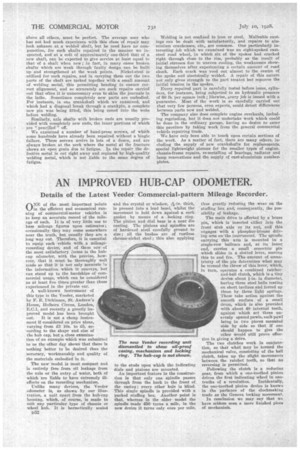AN IMPROVED HUB-CAP ODOMETER
Page 106

If you've noticed an error in this article please click here to report it so we can fix it.
Details of the Latest Veeder Commercial-pattern Mileage Recorder.
ONE of the most important points in the efficient and economical runsling of commercial-motor vehicles is to keep an accurate record of the mileage of each. It is Of very little use to base mileage figures upon estimates; occasionally they may come somewhere near the truth, but usually they are a long way out. Therefore, it is essential to equip each vehicle with a mileagerecording device, and of these one of the most satisfactory forms is the hubcap odometer, with the proviso, however, that it must be thoroughly well made so that it is not only accurate 'n the information which it conveys, but can stand up to the hardships of commercial usage, which can be considered as at least five times greater than those experienced in the private car.
A well-known instrument of this type is the Veeder, marketed by F. E. Dickinson, St. Andrew's House, Holborn Circus, London, E.C.1, and recently a greatly improved model has been brought out. It is not a cheap instrument if considered on price alone,
varying from 13 10s. to according to the shape and size of the hub cap, but a close examina tion of an example which was submitted to us the other day shows that there Is
nothing better to be desired than the accuracy, workmanship and quality of the materials embodied in it.
The new model is most compact and is entirely free from oil leakage from the axle or the entry of water, both of which are liable to have extremely illeffects on the recording mechanism.
Unlike many devices, the Veeder odometer is, as shown by our illus tration, a unit apart from the hub-cap housing, which, of course, is made to snit any particular type of chassis or wheel hub. It is hermetically sealed
D52
end the crystal or window, elcin. thick, is pressed into a lead bezel, whilst the movement is held down against a cork gasket by means of a locking ring. The pinion and dial base is a neat die casting. The pinions and spindles are of hardened steel carefully ground to size; all the bushes are of rustlese chrome-nickel steel; this also applying
to the studs upon which the indicating dials and pinions are mounted.
An important feature in the construction is that only one spindle passes through from the back to the front of the casing; every other hole is blind. This single spindle is provided with a packed stuffing box. Another point is that, whereas in the older model the spindle made 450 turns a mile, in the new device it turns only once per mile,
thus greatly reducing the wear on the stuffing box and; consequently, the possibility of leakage.
The main drive is effected by a brass pin, which is inserted either into the froat stub axle or its nut, and this engages with a phosphor-bronze driving arm on the instrument. The spindle carrying this arm is mounted in a single-row ballrace and, at its inner end, carries a small eccentric pin which slides in a slotted lever, moving this to and fro. The efficient of eccentricity of the pin determines what may be termed the throw of this lever, which, in turn, operates a combined ratchetand-ball clutch, which is a tiny device about fin, in diameter, having three steel balls resting on short inclines and forced up these by three light springs. These take action against the smooth surface of a small. drum, which is also provided with about 40 internal teeth, against which act three unevenly spaced pawls, each pawl being in two pieces mounted side by side so that if one should happen to give the. other would still prove effective in giving a drive.
The two clutches work in CODillriCti0/1, so that what may be termed the mechanical valve, consisting of the ball clutch, takes up the slight movements between the ratchet teeth, so that no reversing is permitted.
Following the clutch is a reducing gear, from which a one-toothed pinion drives the first indicating wheel in one tenths of a revolution. Incidentally, the one-toothed pinion device is known in the parlance of the clockmaking trade as the Geneva locking movement.
In conclusion we may say that we have seldom seen a more finished piece of mechanism.












































































































































































